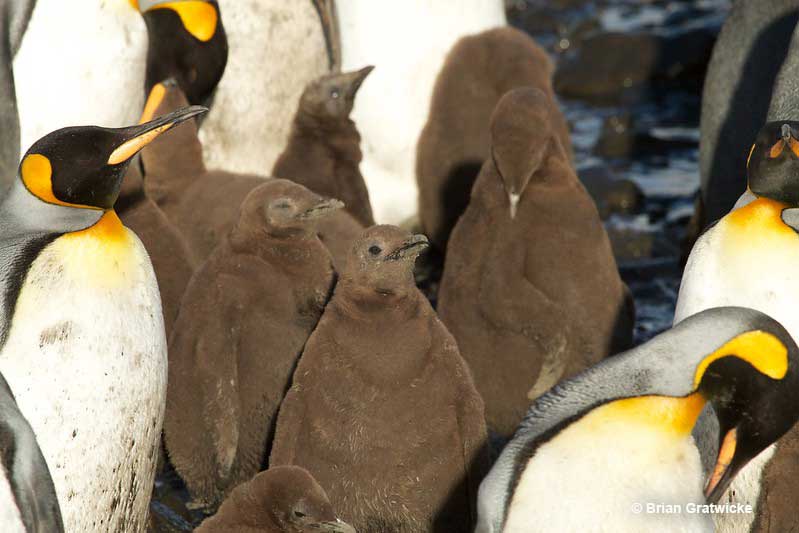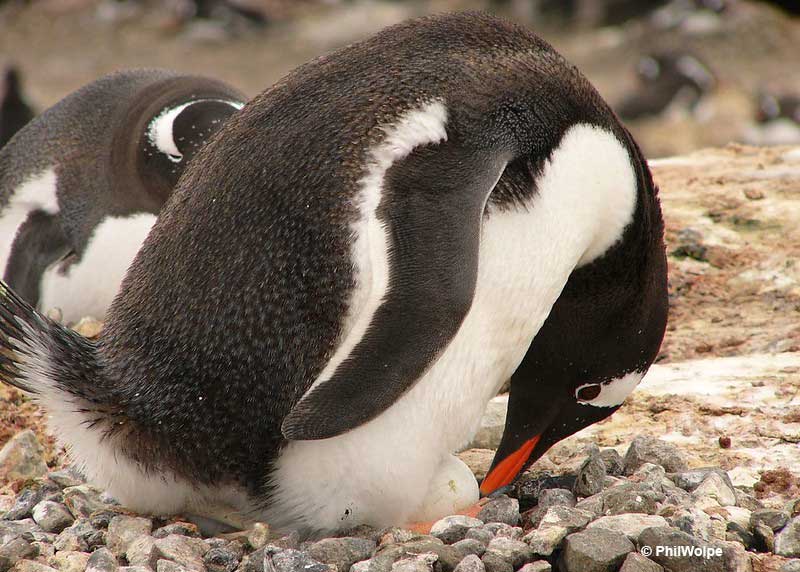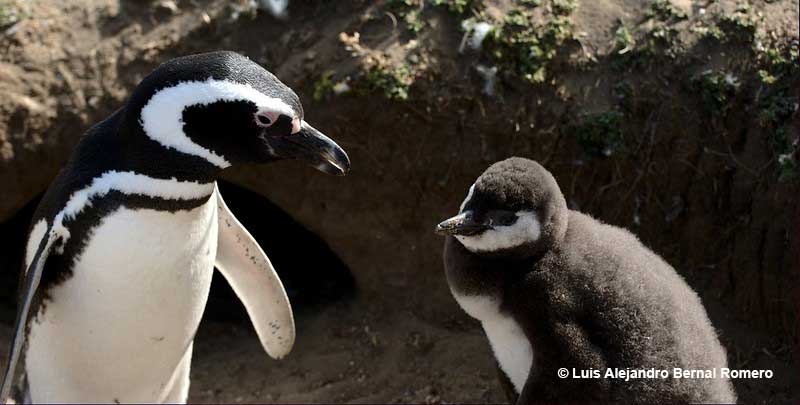
Amongst the chilling ice, rocks, and the deep dark ocean surrounding penguin habitats, there is one heartwarming and soft tale unfolding. It is the life story of baby penguins.
Undoubtedly among the cutest baby animals that ever walked or wobbled the Earth (at least according to human knowledge and standards), the penguin chicks have many interesting quirks. Seemingly delicate, they are actually highly resilient – withstanding the bitter cold, the hunger, and the pecking order of the creche and the whole colony.
If you’ve ever wondered how it feels to grow up as a penguin, read on – we’re diving in!
On this page
Nesting & Eggs
Penguin breeding and nesting strategies highly depend on the species – and there are 18 of them. However, all breed in colonies, and most breed during the Austral (southern) summer.
No penguin species is exceptionally proficient at nest building. Most nests, when they exist at all, are improvised low rock or other material heaps that simply prevent the egg from sliding away. The Emperor penguins live in an extreme Antarctic environment, and they famously do not build nests because there is no nesting material on ice sheets.
Related: What makes penguins birds?
Studies consistently show that penguins are faithful to their colony (or, as it’s otherwise called, rookery) and return yearly. Male Adélie penguins showed 99% loyalty to the previous season’s territory. Gentoo penguins have a modest 63% return rate.
Penguin eggs’ colors vary depending on the species and range from white to bluish. Most penguin species can lay 2-3 eggs per season, and the King Penguins and Emperor Penguins lay only a single egg. Except for the cases of these two penguin giants, where fathers incubate eggs exclusively, both penguin parents take turns incubating the egg in most species.
The egg failure/mortality rate is pretty high and varies from year to year, but it is usually 40-80 percent. Eggs get destroyed by extreme weather events, predators, or even by inexperienced parenting.
The Curious Case of Emperor Penguin’s Egg Care
Emperor Penguins’ breeding cycle begins in the autumn. Although it may seem illogical initially since the most critical incubation period happens during the frigid Antarctic winter, it makes sense that the chicks fledge during the most forgiving part of the year – summer.
Since there is no nest and the ground is notoriously frozen, the male Emperor penguin will carefully prop the egg on its feet and tuck it under his brood pouch. That way, the single egg will receive maximum heat from its dad’s body. The temperature difference inside and outside the pouch can reach more than 80 degrees Celcius!
Related: Where do penguins live?
The incubation lasts for around 65 days, and it is the sole male’s responsibility. The female will head out to the sea to feed and bring back food supplies for the chick. He will not eat for months until the female returns, and he can transfer his parental duties.
What Does a Baby Penguin Look Like?
The color and size of penguin chicks depend on the species. Not all baby penguins are born with feathers – both the King and Emperor Penguins hatch almost naked. For most penguins, it takes one year to reach their full adult plumage.
Most other penguin chicks hatch fully “clothed” – covered in a thick fluffy down. Color and patterns vary between species, but the hues are drab – grey, black, brown, and white. On the other hand, Emperor and King Penguin chicks take several weeks to grow the first down.
Also, the chicks are quite well-developed right after hatching but still cannot survive without a high degree of parental care. Thus, scientists consider them semi-altricial – somewhat able to function on their own and developing faster than average altricial species, but still incapable of surviving without parental care.
Young penguins lose their down feathers as they mature – it is replaced by adult, short, waterproof plumage. The first molt is one of the more critical periods for young penguins.
Because the fluffy down is not waterproof, young penguins must grow adult feathers before venturing into the water to learn to swim proficiently and hunt. This happens around their first birthday, so parents have to extend their care as much as possible.
After leaving the nest and until they reach adulthood, young penguins live in crèches. Crèches are groups of young birds away from the adult part of the colony but still cared for and fed by adults.
How to Tell Baby Penguins Apart?
Penguin chicks are virtually impossible to mistake for any other bird species or type. Their body plan is too unique to be mistaken for any other bird.
However, there can be a mix-up with penguin chicks belonging to different species. Let’s check out their most distinct physical traits.
- Emperor Penguin. Hatch nearly naked; after some time, they gain grey down over their bodies, black helmet-like markings on the head and white cheeks.
- King Penguin. Hatch almost naked; after a while, they grow fully brown first (natal) down that looks like coat.
- Magellanic penguin. Chicks have a greyish-white belly, wing undersides, and faces. The rest of the body (the head and the back) is dark grey, nearly black.
- Adelie Penguin. The first down is very dark brown, nearly black. Later in development, the chicks gain whitish bellies with adult-like patterns.
- Chinstrap Penguin. The first, natal down, is uniformly light gray. Later, juveniles display coloration similar to adults, only much duller.
Probably the best-known baby penguin look belongs to the Emperor Penguin chick. These penguin babies are large and covered in soft, fluffy, downy feathers. As said, the head features a trademark black “helmet,” and the cheeks are white. The tiny black bill is small, adding to the face’s adorable expression.
What do Baby Penguins Eat?
All baby penguins eat a fish-crustacean “soup” regurgitated by their parents. The liquid contains semi-digested foods such as krill and fish. Young chicks will stick their beak into their parents and wait for the delivery.
Related: What do baby birds eat?
It may sound gross to us, but this way, parents ensure their chicks get all the nutrients they need for successful development in a very harsh environment.
Baby Penguin FAQ’s
Are baby penguins soft?
Baby penguins are fluffy – they hatch with a thick layer of soft downy feathers. These feathers help insulate them a bit, but young penguins heavily rely on their parents for warmth and food.
How do baby penguins recognize their parents?
Penguins interact with their parents through vocalizations and location.
Can baby penguins survive alone?
Baby penguins can usually not survive on their own. They are fine for shorter periods but not longer than 4-5 days.


